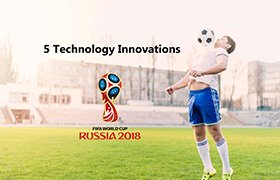5 Technology Innovations In The 2018 Fifa World Cup
Home » 5 Technology Innovations In The 2018 Fifa World Cup
- June 20, 2018

FIFA World Cup has always been the center of introducing new technologies when it comes to sports broadcasting. For example, 2014 saw technologies like vanishing spray, goal-line technology, and mind-controlled robotic suit in action.
As 2018 FIFA World Cup kicks off, we look at the five technology innovations that will be used for the first time in the most significant soccer competition of the world.
1. Video Assistant Referee (VAR)
With the International Football Association Board approving VAR in March 2018, Russia is witnessing the first World Cup using video technology as an additional tool for referees. FIFA has deployed VAR at all the matches, where a dedicated team with a lead VAR and three assistant VARs is located at the Moscow International Broadcast Centre.
According to FIFA, VAR is used as an additional tool to “correct clear and obvious errors and missed incidents in clearly defined match-changing decisions.” 33 broadcast cameras and two dedicated offside cameras are transmitting feeds directly to the VOR using optical fiber – eight of which are in super-slow motion and four in ultra-slow motion. VARs can also speak to the referees on the ground using a fiber-based radio system.
2. Electronic Performance and Tracking System (EPTS)
In 2018 World Cup, the coaches of all the 32 playing teams have access to a tablet-based system to track the statistics and real-time video footage of the players. Based on wearable technology, EPTS is a camera-based system that captures data via two optical tracking cameras on the main stand and selected tactical cameras.
EPTS is considered as the second significant innovation for FIFA after VAR. Each team has three tablets – one each for the analyst on the bench, in the stand, and the medical team. The system will also provide statistics around player positioning, passing, speed, and tackles, and match footages with a maximum of 30-seconds delay.
3. Adidas Telstar Ball
For the first time in the history of FIFA, Adidas, the official manufacturer of the World Cup match ball since 1970, has introduced NFC chip in the ball. Telstar 18 – the ball used for World Cup 2018, includes a Near Field Communication (NFC) chip apart from a new carcass and panel design. The chip allows the ball to communicate with a smartphone. Adidas claims that the new model will dramatically improve the performance durability of the ball.
4. Virtual Reality (VR) and 4K UHD Video
4K UHD videos that were tested in 2014 Brazil World Cup is made available to the broadcasters in 2018 Russia World Cup. BBC has confirmed that 4K streams of the match are available on BBC iPlayer on a first-come-first-served basis.
BBC has also made a VR feed available via its VR application to give the viewers a feeling of watching the match from a private box at the stadium.
5. 5G Services
Though yet to be available commercially, the 2018 World Cup is a testing ground for the 5G services for the network providers. Ericsson and MTS have confirmed to install 5G-capable radio equipment covering cover fan zones, stadiums, transportation hubs, and famous landmarks across more than 40 sites in seven of the 11 host cities.
Additionally, Megafon and TMS – the official communications partner, is holding trials of the 5G network across cities during the event.
While the players play on the ground, sports broadcasters are busy competing for innovations off the field to make the experience more real-time and competition more transparent. But for now, enjoy the game!

